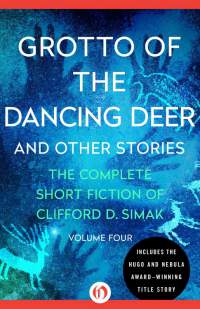
Published by Open Road Media Sci-Fi & Fantasy on March 1, 2016
Grotto of the Dancing Deer is one of several books in a series that will collect all of Clifford D. Simak’s short stories. The stories in this volume are representative of Simak’s range as a writer. Most of them are quite good.
In “Over the River and Through the Woods,” two children show up to visit their grandparents, but the grandparents have never seen the children before. The boy says his father is a temporal engineer, a phrase the grandmother doesn’t understand. Well, you can see where this is going, although the story takes an interesting turn. The story reflects Simak’s love of simple country lifestyles as well as the moral dilemma inherent in time travel. The story is short but powerful. It shows Simak at his best.
“Grotto of the Dancing Deer” is about a 20,000-year-old man. He’s the original survivalist and he does it without a bug-out bag, because survival is about instinct and judgment, not gear and guns. The story’s well-deserved awards include a Hugo and a Nebula. Its point, I think, is that having a friend who understands you, even if the friendship is fleeting, is the true key to survival.
“The Reformation of Hangman’s Gulch” is one of Simak’s westerns. It has the hallmarks of a classic western, including the theme of good versus evil, but the good guy isn’t all that good, giving the story the kind of subtlety that Simak brought to much of his fiction. The dialog could have been better but the story is entertaining.
In “The Civilization Game,” the human race is striving to preserve its culture (everything from art to politics to war) as humans become a minority in the galactic matrix. Those who try to preserve human achievements discover that many of them (like political assassination) are quite ugly. Simak gives a clever twist to the notion of cultural preservation as the story ends.
“Crying Jag” is about an alien (and his robot) who comes to a small town and listens to the sad stories people love to tell about their lives. They feel better after confessing their sorrows, making the alien seem like a priest or psychiatrist, but the alien listens to the stories because they have the same effect on aliens that alcohol has on humans. The gentle humor and the twisted ending are typical Simak, but the story is also typical of Simak’s ability to make a profound point with a simple story.
“The Hunger Disease” was written when sf authors thought that Venus was just a rainy version of Earth. Colonists on Venus come down with a fatal disease that makes them insatiably hungry. A reporter wonders if there’s a connection between the disease and a visit by a colonist from Mars. Simak’s appreciation of agrarian life and its rigors is evident the story, as is his love of westerns. The story, in fact, gives a science fiction twist to a traditional western theme of a man fighting to save his land from swindlers who file an opposing claim. Add a Martian conspiracy, and you’ve got classic Simak.
“Mutiny on Mercury” is probably the first published story that Simak wrote, although it took him a while to sell it. It’s sort of a John Carter story that is easily skipped.
The spaceship crew in “Jackpot” spend their time plundering planets. They come across a planet with only one structure. It appears to be an immense library. This creates a moral dilemma -- should they rob the library, a prospect that will finally give them the wealth they want, or should they leave it for the rest of the galaxy to enjoy? Should education be freely available to benefit all of humankind or should it be sold at a profit to those who can afford it? Is honesty the most important value, even if it leads to complacency? Simak excelled at stories that ask moral questions. This one stands out.
Some aspects of “Day of Truce” reminded me of the first stories in City: the tension between city dwellers and those who are turning the country into cities with larger yards; the tension between generations; the difficulty of living in peace when people have their minds set on conflict. The story builds on a shrewd version of the angry old man who shakes a fist while yelling “you kids get off my lawn.” The story also asks whether a preemptive strike can ever be justified as self-defense. This isn’t one of Simak’s best, but it’s a good effort.
“Unsilent Spring” returns to one of Simak’s favorite themes -- the merits of simple country lifestyles. A rural doctor is asked to keep an eye out for a strange malady that is becoming epidemic. Symptoms include lethargy, abnormal blood sugar, and an increased appetite. Only townfolk complain of those symptoms; country and hill folk seem to be immune. The hill people, in particular, are healthy and self-sufficient, surviving on the food they grow, the fish and game they catch, the few cows and pigs they own. They are “happy, reliable, proud, and independent people, filled with dignity and inborn curiosity” -- the kind of people Simak extolled in his fiction. The story is sort of an ode to country doctors. The solution to the medical mystery might be a little silly, but it’s consistent with Simak’s lifelong interest in the process of evolution.
RECOMMENDED